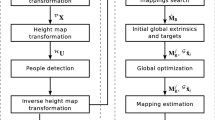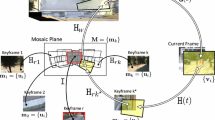Abstract
Wide-area context awareness is a crucial enabling technology for next generation smart buildings and surveillance systems. It is not practical to gather this context awareness by covering the entire building with cameras. However, significant gaps in coverage caused by installing cameras in a sparse way can make it very difficult to infer the missing information. As a solution we advocate a class of hybrid perceptual systems that build a comprehensive model of activity in a large space, such as a building, by merging contextual information from a dense network of ultra-lightweight sensor nodes and video from a sparse network of cameras. In this paper we explore the task of automatically recovering the relative geometry between a pan-tilt-zoom camera and a network of one-bit motion detectors. We present results both for the recovery of geometry alone and also for the recovery of geometry jointly with simple activity models. Because we do not believe a metric calibration is necessary, or even entirely useful, for this task, we formulate and pursue the novel goal we term functional calibration. Functional calibration is a blending of geometry estimation and simple behavioral model discovery. Accordingly, results are evaluated by measuring the ability of the system to automatically foveate targets in a large, non-convex space, rather than by measuring, for example, pixel reconstruction error.
Similar content being viewed by others
References
Bagdanov A.D., del Bimbo A.:, Pernici, 7F.: Acquisition of high-resolution images through on-line saccade sequence planning. In: Proceedings of Third ACM International Workshop on Video Surveillance and Sensor Networks, pp. 121–130, Singapore (2005)
Baker P., Aloimonos Y. (2003) Calibration of a multicamera network. In: Pless R., Santos-Victor J., Yagi Y. (eds). The fourth Workshop on Omnidirectional Vision, Camera Networks and Non-classical cameras. Madison, Wisconsin USA
Barreto J., Daniilidis K.: Wide area multiple camera calibration and estimation of radial distortion. In: Sturm P., Svoboda T., Teller S. (eds.) The fifth Workshop on Omnidirectional Vision, Camera Networks and Non-classical cameras. Prague (2004)
Collins R.T., Tsin Y.: Calibration of an outdoor active camera system. In: Computer Vision and Pattern Recognition. Fort Collins, CO, USA IEEE, pp. 528–534 (1999)
Forsyth D.A., Ponce J.: Computer Vision: A Modern . Prentice Hall (2003)
Hartley R.I.: Self-calibration from multiple views with a rotating camera. In: The Third European Conference on Computer Vision, Stocklholm, Sweden Springer-Verlag, pp. 471–478, (1994)
Ivanov Y.A., Bobick A.F. (2000) Recognition of visual activities and interactions by stochastic parsing. Transactions on Pattern Analysis and Machine Intelligence 22(8): 852–872
Jung B., Sukhatme G.S.: Cooperative tracking using mobile robots and environment-embedded, networked sensors. In: Proceedings of the International Symposium on Computational Intelligence in Robotics and Automation, pp. 206–211, Banff, Alberta, Canada (2001)
Kaelbling L.P., Littman M.L., Moore A.W. (1996) Reinforcement learning: A survey. J. Artif. Intell. Res. 4, 237–285
Khan S., Javed O., Shah M.: Tracking in uncalibrated cameras with overlapping field of view. In: Workshop on Performance Evaluation of Tracking and Surveillance. IEEE (2001)
Lim S.N., Davis L.S., Elgammal A.: A scalable image-based multi-camera visual surveillance system. In: IEEE AVSS, , Florida (2003)
Minnen D., Essa I., Starner T.: Expectation grammars: Leveraging high-level expectations for activity recognition. In: Workshop on Event Mining, Event Detection, and Recognition in Video, held in Conjunction with Computer Vision and Pattern Recognition, vol. 2, pp. 626. IEEE (2003)
Qureshi F., Terzopoulos D.: Surveillance camera scheduling: a virtual vision approach. In: Proceedings of Third ACM International Workshop on Video Surveillance and Sensor Networks, pp. 131–139, Singapore (2005)
Rahimi A., Dunagan B., Darrell T.: Simultaneous calibration and tracking with a network of non-overlapping sensors. In: Computer Vision and Pattern Recognition, pp. 187–194. IEEE Computer Society (2004)
Shet V., Harwood D., Davis L.: Multivalued default logic for identity maintenance in visual surveillance. In: European Conference on Computer Vision, Graz, Austria, (2006) (to)
Sinha S.N., Pollefeys M.: Towards calibrating a pan-tilt-zoom cameras network. In: Sturm P., Svoboda T., Teller S., (eds.) The fifth Workshop on Omnidirectional Vision, Camera Networks and Non-classical cameras, Prague (2004)
Sony Corporation. SNC-RZ30 CGI command manual, 2.0 edn (2003)
Stauffer C., Tieu K.: Automated multi-camera planar tracking correspondence modeling. In: Computer Vision and Pattern Recognition, pp. 259–266. IEEE (2003)
Stein G.P.: Tracking from multiple view points: Self-calibration of space and time. In: Image Understanding Workshop, Montery, CA, USA, DARPA (1998)
Munguia Tapia E., Intille S.S., Lopez L. Larson K.: The design of a portable kit of wireless sensors for naturalistic data collection. In: Proceedings of PERVASIVE 2006, Dublin, Ireland, Springer-Verlag (2006)
Thrun S., Fox D., Burgard W.: A probabilistic approach to concurrent mapping and localization for mobile robots. Mach. Learn. Auton. Robots (joint issue), 31(5), 29–53 & 253–271 (1998)
Toyama K., Krumm J., Brumitt B., Meyers B.: Wallflower: Principles and practice of background maintenance. In: ICCV, pp. 255–261. IEEE (1999)
Trajkovic M.: Interactive calibration of a pan-tilt-zoom (ptz) camera for surveillance applications. In: Asian Conference on Computer Vision (2002)
Trivedi M.M., Prati A., Kogut G.: Distributed interactive video arrays for event based analysis of incidents. In: International Conference on Intelligent Transportation Systems, pp. 950–956, Singapore, IEEE (2002)
Wren C.R., Minnen D., Rao S.G.: Similarity-based analysis for large networks of ultra-low resolution sensors. Recognit, 39(10), 1918–1931, Special Issue on Similarity-Based Pattern Recognition (2006)
Wren C.R., Tapia E.M, Toward scalable activity recognition for sensor networks. In: Lecture Notes in Computer , vol. 3987, pp. 168–185, Dublin, Ireland 2nd International Workshop on Location- and Context-Awareness (2006)
Author information
Authors and Affiliations
Corresponding author
Rights and permissions
About this article
Cite this article
Wren, C.R., Erdem, U.M. & Azarbayejani, A.J. Functional calibration for pan-tilt-zoom cameras in hybrid sensor networks. Multimedia Systems 12, 255–268 (2006). https://doi.org/10.1007/s00530-006-0061-x
Published:
Issue Date:
DOI: https://doi.org/10.1007/s00530-006-0061-x
Categories and Subject Descriptors
- I.2.10 [Vision and Scene Understanding]: Motion
- I.2.10 [Vision and Scene Understanding]: Video analysis
- I.4.8 [Scene Analysis]: Sensor fusion
- I.2.9 [Robotics]: Sensors
- C.3 [Special-purpose and application-based systems]: Real-time and embedded systems




